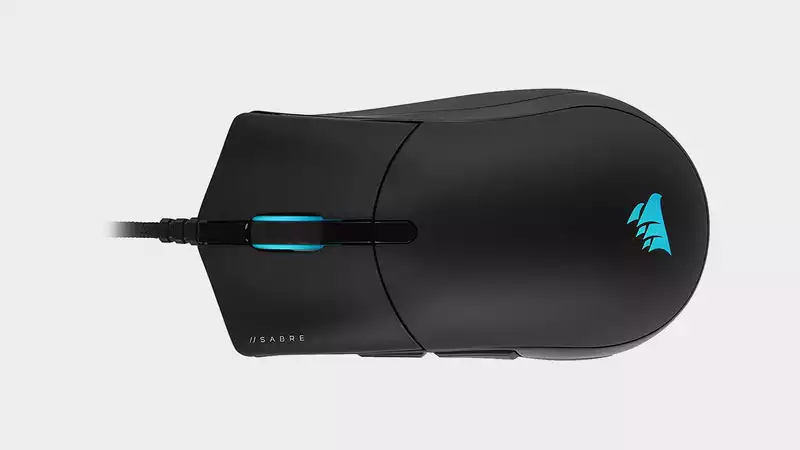The Corsair Sabre RGB Pro Champion Series optical gaming mouse is yet another terribly over-named gaming peripheral. As a consumer, it means nothing. Yet what Corsair has done here is the furthest thing from normal gamer excess. They stripped away everything unnecessary and offered a high-performance esports mouse that weighs as little as 74 grams for the astounding price of $60.
When I pulled it out of the box, I was struck by its simplistic look; Corsair has wasted no resources on flashy, edgy designs, rainbow RGB, or holes in the shell. And while it may look simple, it's more like a sword than an Iron Man suit.
The shape is nearly symmetrical, fitting snugly in the palm of the hand and allowing for a confident grip without slipping. The tapered sides allow for comfortable placement of the thumb and pinky finger. Some may find it a bit large, but I found it to be a perfect fit for my usual palm grip.
The main mouse button and thumb button, unlike the rest of the mouse, are slightly textured for an improved grip. Like the main button buttons, the thumb button also has two clicky buttons and uses Corsair's QuickStrike switches, a design that has no gap between the buttons and the Omron switches. This seems to make them faster, more responsive, and more stable. However, to be honest, I didn't notice any difference compared to my previous Razer Basilisk Ultimate.
There is an LED indicator on the front of the thumbwell that shows which DPI preset the mouse is on. When the button behind the scroll wheel is used to switch DPI, the three light bars alternate. Presets can be adjusted using the Corsair iCue software and can also be saved directly to the mouse.
Thanks to the 18,000 DPI optical sensor, it can be adjusted in steps from 100 to 18,000 DPI. I find that between 600 and 1800 is more than enough for gaming and work, so I don't think I would use a much higher DPI.
But what really makes the Sabre Pro special is the 8,000 Hz polling rate. Whereas a typical gaming mouse has a polling rate of 1,000 Hz, the Sabre Pro has a polling rate of 8,000 Hz. Again, we did not notice any difference in response speed, nor was there any scientific way to measure it. It may be for professionals.
However, according to Corsair, the AXON Hyper-processing technology required to sustain this fast polling requires a powerful CPU to keep up with it, although iCUE warns me every time I enable 8K polling, I was testing this on an Alienware R11 with an i9-10900K processor and did not notice any performance issues. Nevertheless, if you are using a lower-performance processor, such as a quad-core i3 Intel, you may see a performance drop.
And this is not the only change you can make with the iCUE software. There are also plenty of controls to fine-tune Sabre Pro to your liking. The two-zone RGB lighting on the scroll wheel and on the Corsair logo on the back of the mouse can also be adjusted; the RGB is impressively bright, but we did not find much flexibility or interest in customization beyond static or rotating colors. I would have liked more gradients and flowing color effects.
Each of the six buttons on the Sabre Pro can also be reassigned in iCUE. The macro editor is very simple and allows you to capture and assign any key you like.
What I found strange is that there are no presets for popular games like there are on the Razer Synapse. This is useful when creating different mouse profiles that can be assigned to specific games. This way, every time you change apps or games, iCUE will automatically change the mouse profile settings. Excellent.
In addition, Corsair has incorporated a drag-reducing Paracord USB cable into the Sabre Pro so that ultra-fast polling signals and fast hand movements are not slowed down by dragging along the surface.
Speaking of which, there is a replaceable 100% PTFE glide pad, and the entire mouse pad is very smooth. I very much prefer a wireless mouse, but the fact that I could barely remember the Sabre Pro being tethered is a good indication that the Paracord is working as advertised.
I'm very impressed with what Corsair has accomplished with the Sabre Pro; it's cheaper than Razer's Viper 8KHz, and the fact that the Sabre Pro is so cheap is a good sign.
The combination of 8,000Hz polling and 18,000 DPI sensor is definitely overkill for most gamers, but professional gamers will appreciate the design choices that make this ideal for competitive play. For the rest of us, this is a comfortable, responsive, and hugely profitable mouse, and one of the best wired gaming mice I've ever used.
.

Comments